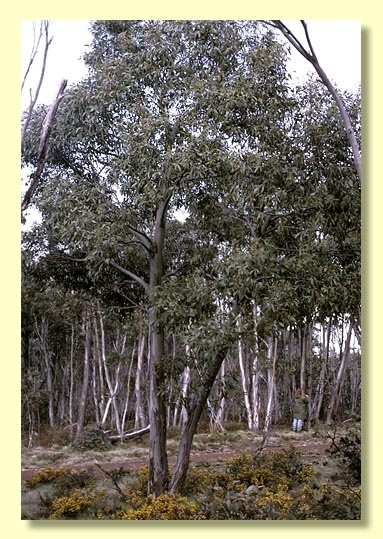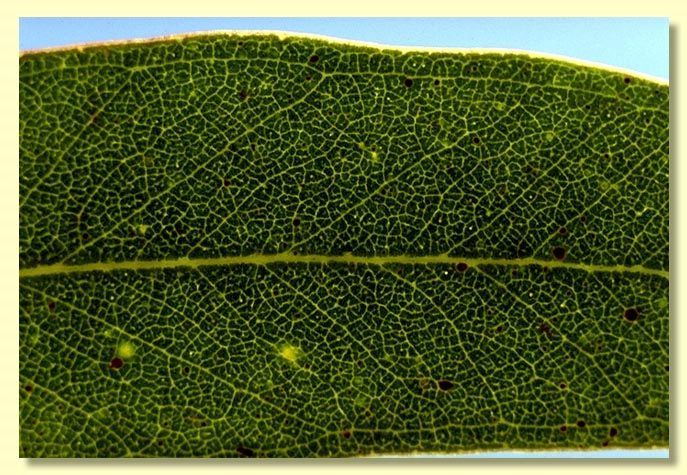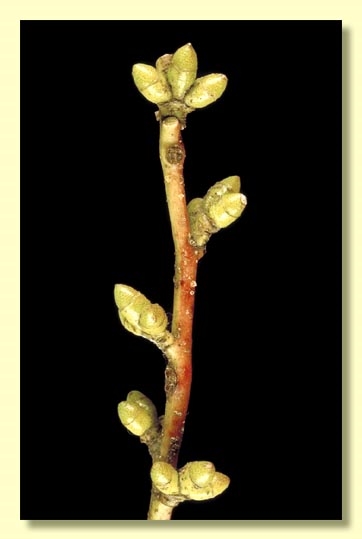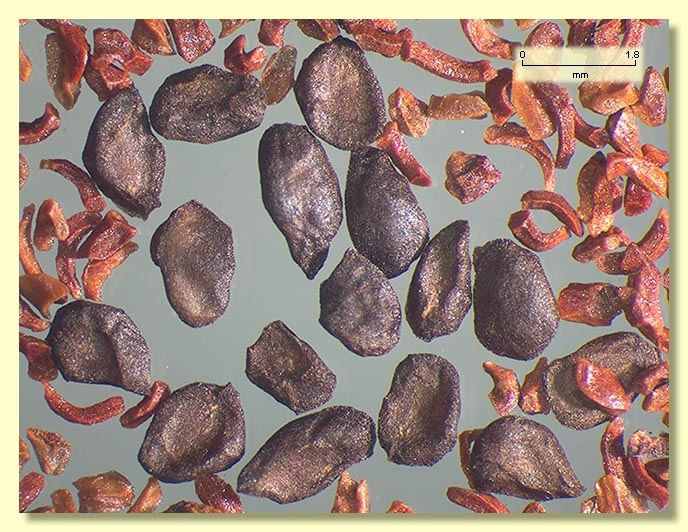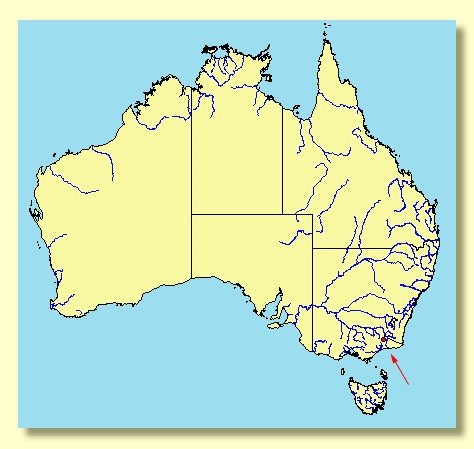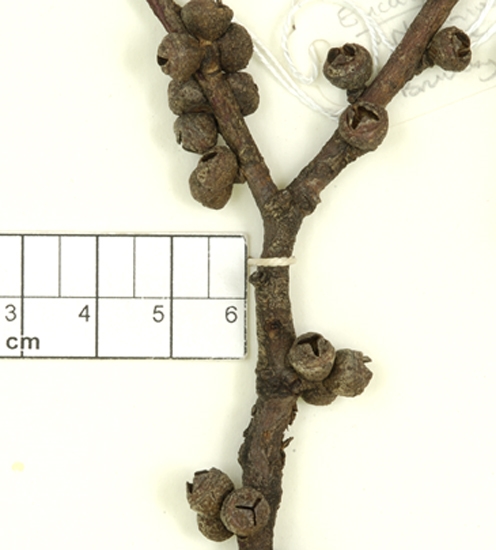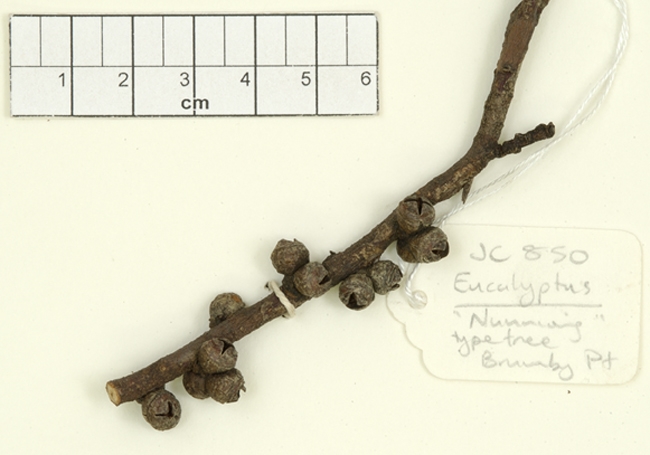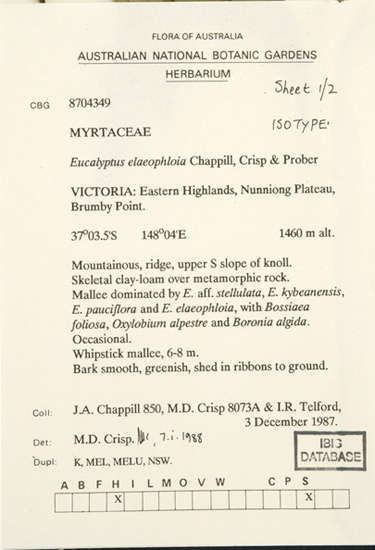Euclid - Online edition
Eucalyptus elaeophloia
Eucalyptus | Symphyomyrtus | Maidenaria | Euryotae | Semiunicolores
T: Vic., Nunniong Plateau, Brumby Point, 3 Dec. 1987, J.Chappill 850, M.D.Crisp & I.R.Telford; holo: MEL; iso: CANB, K, MELU, NSWm
Bark smooth throughout or with some persistent rough bark at the base of stems; smooth bark green to grey-green with coppery or brown patches.
Juvenile growth (coppice or field seedlings to 50 cm): stems square or round in cross-section, slightly glaucous or non-glaucous, warty or smooth; juvenile leaves opposite, sessile for ca 8 to 13 nodes then alternate, petiolate, at first orbicular becoming elliptic to ovate, 3–4 cm long, 2–4 cm wide, apex rounded or emarginate, margin entire or crenulate, base amplexicaul to rounded, dull, green to blue-green, slightly glaucous at growing tips but soon weathering to non-glaucous.
Adult leaves alternate, petiole 0.8–2 cm long; blade lanceolate to falcate or ovate, 7–11.5 cm long, 1.2–2.5 cm wide, glossy, green, side-veins usually greater than 45° to midrib, densely reticulate, intramarginal vein parallel to and remote from margin, oil glands island or obscure.
Inflorescence axillary unbranched, peduncles 0.2–0.4 cm long, buds 3 per umbel, usually sessile (rarely with 0.1 cm pedicel). Mature buds ovoid, 0.5–0.7 cm long, 0.3–0.5 cm wide, green, scar present, operculum conical, stamens inflexed, anthers cuboid to cuneate, versatile, dorsifixed, dehiscing by longitudinal slits (non-confluent), style long, locules 3 or 4, the placentae each with 4 vertical ovule rows. Flowers white.
Fruit sessile, obconical or hemispherical, 0.4–0.5 cm long, 0.6–0.8 cm wide, disc raised-convex, valves 3 or 4, strongly exserted.
Seeds black or brown, 1.5–2.5 mm long, ovoid or flattened-ovoid, lacunose, dorsal surface smooth, hilum ventral.
Cultivated seedlings (measured at ca node 10): cotyledons bilobed to oblong; stems rounded or square in cross-section, warty or smooth, sometimes glaucous; leaves sessile, opposite for 9 to 15 nodes or sometimes remaining opposite for longer, orbicular to ovate, 2–4.5 cm long, 2.5–5 cm wide, amplexicaul, margin entire or subcrenulate, apex rounded to emarginate, concolorous, dull, green to grey-green.
Flowering has been recorded in March.
A small tree or mallee of very restricted distribution on the Nunniong Plateau and nearby Brumby Point in highlands in eastern Victoria. It is a small tree with green to coppery smooth bark, sessile opposite juvenile leaves at first orbicular becoming elliptic, and have subcrenulate margins, glossy green adult leaves and sessile buds in 3s.
E. elaeophloia may be confused with three other three-budded species in the area, viz. E. perriniana, which is easily distinguished by the connate pairs of juvenile leaves that are invariably present in regrowth and in coppice on mature plants; E. dalrympleana, which has pedicellate buds and fruit; and E. glaucescens, which has glaucous buds and fruit. E. elaeophloia is closely related to E. imlayensis of Mt Imlay in far south-eastern New South Wales, which differs by having elliptical not orbicular early juvenile leaves.
Eucalyptus elaeophloia belongs in Eucalyptus subgenus Symphyomyrtus section Maidenaria, a large group of species more or less restricted to south-eastern Australia, characterised by bilobed cotyledons, simple axillary inflorescences, buds with two opercula, stamens with versatile anthers and flattened seeds with a ventral hilum. Within this section, E. elaeophloia, with four other species, forms series Semiunicolores having smooth bark, subcrenulate and strongly glandular juvenile leaves opposite for many nodes, a crown of green densely and finely reticulate adult leaves, buds in threes, and small fruit with relatively prominent valves. Three of the species in series Semiunicolores are Tasmanian endemics, viz. E. johnstonii, E. subcrenulata and E. vernicosa; the fourth species is E. imlayensis mentioned above.

